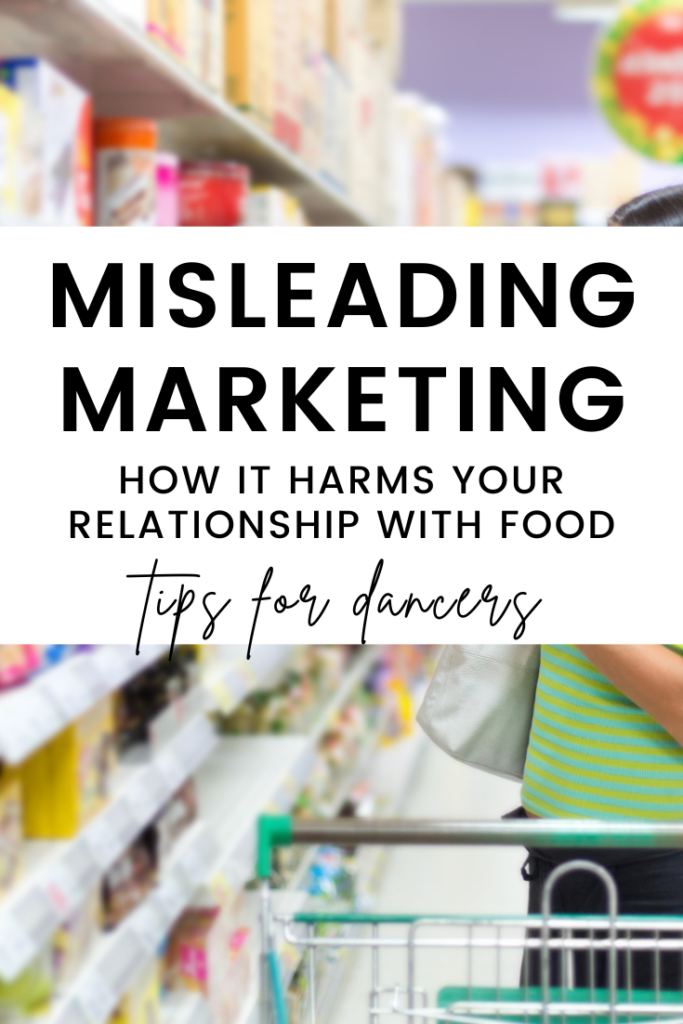Marketing is a powerful tool in shaping our purchasing decisions. For many, wellness is especially appetizing as an alternative goal to heal from, prevent, or even “restore” underlying medical conditions in a seemingly “wholesome” way (as compared to conventional medicine practices). Cultural beauty standards also play a role— often a guise for what wellness can ultimately “look” like.
But when it comes to food and nutrition, it is crucial to be aware of particularly deceptive marketing phrases. Those that might seem harmless, but in reality, mislead us into developing restrictive food rules, food guilt, and worse, disordered eating. In this blog post, we’ll explore the most common marketing phrases that dancers should recognize and steer clear of in their mealtime decisions.
5 marketing claims that can hurt a dancer’s relationship with food
#1: “Only ingredients you can see and pronounce!”
It is not necessarily wrong to choose foods with ingredients you can see and pronounce, as it can be a way to decipher nutrient-dense options. But it’s important to recognize that a food’s nutrient density is not solely defined by the complexity or familiarity of its ingredients. In fact, a “good” food choice for a dancer goes beyond its nutritional characteristics— The Healthy Dancer® is built on a framework that encourages dancers to look beyond this.
The same holds true for food processing. I’ve previously discussed the realities of food processing and why dancers need not fear it. Sometimes, processed foods may contain additives or preservatives with long or scientific names that might sound unfamiliar. These ingredients are tested for safety and approved by regulatory bodies. On a similar note, even foods that require no level of processing— whole fruits, grains, water— are rich in bioactive compounds that even most nutrition professionals cannot pronounce.
#2: “… it’s guilt-free!”
This one’s less obvious because as a non-diet dietitian, much of my work involves helping dancers free themselves from food guilt. So “guilt-free” eating patterns is definitely a phrase you’ll find in my work. But when it comes to how we describe specific foods and/or eating habits, understand that guilt should never be involved. This also holds true for movement, exercise, and rest. Even dancers who struggle with patterns of overexercising, guilt needs to be replaced with self-compassion in order to dismantle the very thoughts driving those unsustainable behaviors.
Merely suggesting that a specific type of food is “guilt-free” often leads us to think that an alternative option should induce guilt. I often see this phrase used on food packages boasting a lower sugar content or sugar-free alternative. But instead of reinforcing a guilt-free approach to eating, we’re manipulated into thinking that an alternative choice should come served alongside guilt.
#3: “Clean ingredients!”
Similar to those “guilt-free” foods, “clean” eating induces food fears around those not being deemed “acceptable” or “healthy.” I’ve previously uncovered the harms of “clean” eating for dancers. But one of the main issues with marketing that promotes “clean” ingredients is in its ability to decontextualize nutrition information and ultimately, seem harmless. Here’s an example:
“…A healthy diet is built on a foundation of whole, clean, and minimally processed foods.” If we break down this statement, it is true that whole and minimally processed foods are chock full of nutrients. But it’s important to know that foods that are not whole nor minimally processed are chock full of nutrients, also. In fact, food processing broadens our food supply and access to MOST nutrients. For many dancers, however, this seemingly harmless phrase translates into “everything I eat needs to be minimally processed or it’s NOT healthy.”
#4: “Superfoods!”
This one is straightforward: all foods are super! Yes, some foods might have a higher degree of nutrient density than others, but this doesn’t mean that foods with a lower nutrient density are not nourishing choices. The same holds true for words like “all-natural,” which often implies foods are chock full of “wholesome” ingredients. First and foremost, these terms aren’t regulated (so anyone can use them). And most importantly, recognize that these phrases do not mean any food is superior to another. Here’s an article that uncovers the topic of superfoods and what dancers can look out for.
#5: “Food Freedom!”
Another confusing phrase that even we non-diet dietitians use is “food freedom.” What started as an attempt to support anti-diet rhetoric is now often coerced into being a guise for otherwise restrictive diets. There are a handful of key red flags to consider when understanding how to dismantle dancer diet culture— deciphering what’s actually “anti” diet from what isn’t is important.
In my work with dancers, I make an active effort to encourage the dismantling of the dieting mentality because striving to ignore or “ditch” it sets an unrealistic standard. Dancer diet culture will unfortunately be around for quite a while and focusing solely on rejecting it leaves dancers lingering in a place where eating feels unstructured and unsupported. This is why The Healthy Dancer® takes a more proactive perspective with the first fundamental stage being to dismantle dancer diet culture.
Marketing phrases can be deceiving, especially surrounding food and nutrition. To make informed choices, it’s crucial to look beyond the buzzwords. This doesn’t mean we shouldn’t purchase foods with these claims— that would be limiting in itself! Rather, we need to recognize that food labels and seemingly harmless phrases don’t have to drive our mealtime decisions (unless, of course, it’s related to an allergy or intolerance). Tools like gentle nutrition and The Healthy Dancer® Food Flexibility Algorithm are fabulous places to start.



